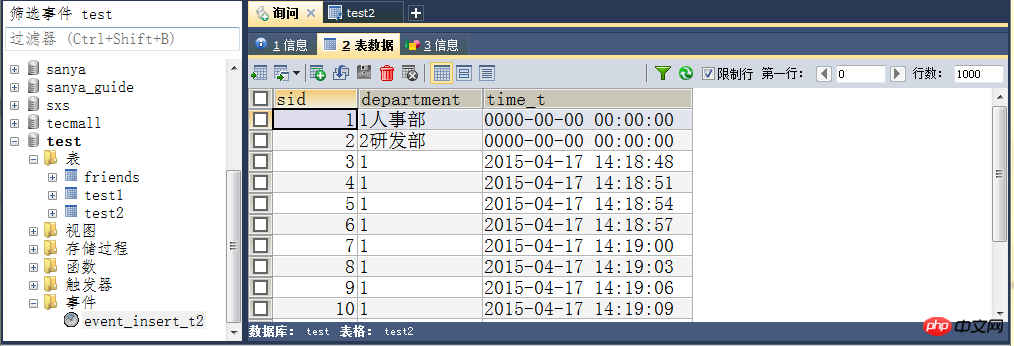
EventThe scheduler is a newly added function after MySQL5.1, you can press the database A custom time period triggers a certain operation, which can be understood as a time trigger , is similar to the task scheduler crontab under the <a href="//m.sbmmt.com/wiki/1497.html" target="_blank">linux</a> system, or similar to the plan under the window Task. It is worth mentioning that MySQL's event scheduler can execute one task per second, while the operating system's scheduled tasks (such as CRON under Linux or task planning under Windows) can only execute one task per minute.
When using the event function, first make sure that your mysql version is 5.1 or above, and then check your mysql server Whether the event is enabled.
To check whether the event is enabled, use the following command to check:
#方式一 SHOW VARIABLES LIKE 'event_scheduler'; #方式二 SELECT @@event_scheduler; #方式三 SHOW PROCESSLIST; #查看事件状态 SHOW EVENTS;
If you see event_scheduler is on or event_scheduler information is displayed in PROCESSLIST, the event has been enabled. If it is displayed as off or the event_scheduler information cannot be seen in PROCESSLIST, it means that the event is not enabled and we need to enable it.
Method 1. Modify through dynamic parameters
SET GLOBAL event_scheduler = ON;
After changing this parameter, it will take effect immediately. But restarting mysql restored it, that is, the settings cannot span restarts.
Method 2. Change the configuration fileand then restart
Add the following content to the [mysqld] section in my.cnf, and then restart mysql.
event_scheduler=ON;
Once and for all, you need permission to modify the database configuration.
Method 3: Add “–event_scheduler=1” directly to the startup command
mysqld ... --event_scheduler=ON
CREATE
[DEFINER = { user | CURRENT_USER }]
EVENT
[IF NOT EXISTS]
event_name
ON SCHEDULE schedule
[ON COMPLETION [NOT] PRESERVE]
[ENABLE | DISABLE | DISABLE ON SLAVE]
[COMMENT 'comment']
DO event_body;
schedule:
AT timestamp [+ INTERVAL interval] ...
| EVERY interval
[STARTS timestamp [+ INTERVAL interval] ...]
[ENDS timestamp [+ INTERVAL interval] ...]
interval:
quantity {YEAR | QUARTER | MONTH | DAY | HOUR | MINUTE |
WEEK | SECOND | YEAR_MONTH | DAY_HOUR |
DAY_MINUTE |DAY_SECOND | HOUR_MINUTE |
HOUR_SECOND | MINUTE_SECOND}DEFINER: Define the user who checks permissions when the event is executed.
ON SCHEDULE schedule: Define the execution time and interval.
ON COMPLETION [NOT] PRESERVE: Define whether the event is executed once or permanently. The default is one execution, that is, NOT PRESERVE.
ENABLE | DISABLE | DISABLE ON SLAVE: Define whether the event is turned on or off after it is created, and whether it is turned off from above. If the slave server automatically synchronizes the statement of the creation event on the master, DISABLE ON SLAVE will be automatically added.
COMMENT 'comment': Comment that defines the event.
ALTER
[DEFINER = { user | CURRENT_USER }]
EVENT event_name
[ON SCHEDULE schedule]
[ON COMPLETION [NOT] PRESERVE]
[RENAME TO new_event_name]
[ENABLE | DISABLE | DISABLE ON SLAVE]
[COMMENT 'comment']
[DO event_body]DROP EVENT [IF EXISTS] event_name;
Example 1
Send to table test2 every 3 secondsInsert data
create event event_insert_t2 on schedule every 3 second on completion preserve do insert into test2(department,time_v) value('1',now());
Execution result

Example 2Create an event that clears the test table data after 10 minutes
CREATE EVENT IF NOT EXISTS event_truncate_test2 ON SCHEDULE AT CURRENT_TIMESTAMP + INTERVAL 10 MINUTE DO TRUNCATE TABLE test2;
Example 3Create an event at 2015-04-17 14:42:00 Event of clearing test table data
DROP EVENT IF EXISTS event_truncate_test2; CREATE EVENT event_truncate_test2 ON SCHEDULE AT TIMESTAMP '2015-04-17 14:42:00' DO TRUNCATE TABLE test2;
Example 4Start inserting data into table test2 every 3 seconds after 5 days, and stop execution after one month
CREATE EVENT IF NOT EXISTS event_truncate_test2 ON SCHEDULE EVERY 3 SECOND STARTS CURRENT_TIMESTAMP + INTERVAL 5 day ENDS CURRENT_TIMESTAMP + INTERVAL 1 month ON COMPLETION PRESERVE DO INSERT INTO test2(department,time_v) VALUES('1',NOW());
Example 1Temporarily close event
alter event event_insert_t2 disable;
DROP EVENT IF EXISTS event_insert_t2;
Stored procedure or function is like a normal call.
Suitable for regular collection of statistical information, regular clearing of historical data, regular database checks, etc.
Free mysql online video tutorial
2.3. Boolean Education Yan Shiba mysql introductory video tutorial
The above is the detailed content of Detailed explanation of MySQL's new functions (event scheduler) examples. For more information, please follow other related articles on the PHP Chinese website!




